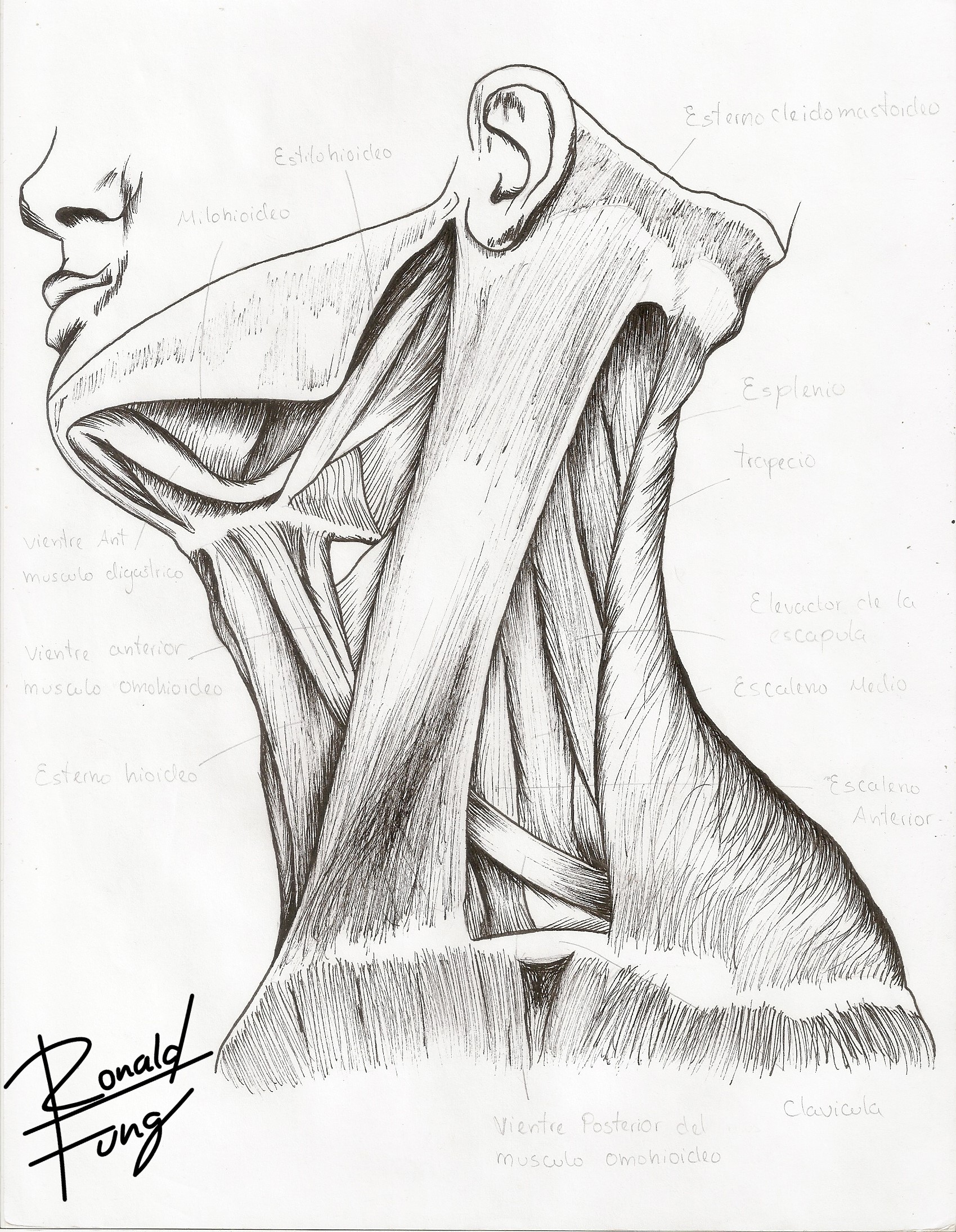A Work In Progress - 11
In the neck muscles you can find three regions:
a) Lateral region of the neck: squamous muscle of the neck, sternocleidomastoid muscle, scalene muscles (anterior, middle and posterior), lateral rectus muscle of the head
b) Anterior or hyoid region: it is divided into suprahyoids (digastric muscle, stylohyoid muscle, myohyoid muscle, genital muscle) and infrahyoid (sternohyoid, omohyoid, sternothyroid, thyrohyoid muscle).
c) Prevertebral region or posterior of the neck: Trapezius, anterior rectum of the head, anterior small rectus of the head and long neck muscle.

ESPLENIO: is located below the trapezius and the sternocleidomastoid, it is a wide and thin muscle that occupies the entire height of the nape and the upper part of the back.
a)Origin: Originates in the lower half of the ligament of the nape and in the spinous processes of the last cervical vertebrae and the 3 or 4 first dorsal vertebrae, as well as in the caudal third of the dorsal cervical ligament. From here their fibers are directed cranially and laterally.
b) Insertion: Those that come from the cranial part form a flattened muscular body, which is inserted in the lateral two thirds of the cranial occipital line and in the lateral face of the mastoid process: it is the splenius capitis. Those that come from the caudal part surround the lateral border of the splenius of the head and end up being inserted in the dorsal tubercle of the costotransverse process of the third cervical and, sometimes of the second. This part is called splenius cervicis.
c) Action: It has a unilateral and a bilateral function; the first is the inclination and rotation of the head to the same side, the second is extension or hyperextension of the skull and neck.
STERNOCLEIDOMASTOID: is a muscle of the lateral face of the neck, in the anterolateral region; long, robust, constituted in its thoracic section by two bundles or heads: the sternal, cylindrical, and the clavicular, flattened.
a) Origin: Mango of the sternum and medial portion of the clavicle. It presents, in its thoracic origin, two distinctly distinct portions: an internal portion, originated in the sternum, and an external portion, originated in the clavicle. The first has received the name of sternal head, the second of clavicular head.
The sternal head is pulled from the anterior side of the sternum through a powerful tendon, whose more medial fibers often intersect with those on the opposite side and the clavicular head is inserted into the posterior part of the superior aspect of the medial third of the clavicle by means of short interspersed fleshy and tendinous fibers. These two lower extremes, initially differentiated, meet somewhat higher, forming the triangle of Sedillot with the clavicle.
b) Insertion: Mastoid process of the temporal and superior nuchal line.
c) Action: It is flexor, inclining and rotating of the head. This muscle allows three different actions: the rotation of the head to the opposite side, the lateral inclination, and a slight extension of the head. Simultaneously: extension of the head on the neck and in isolation: disconnects the head towards the contracting muscle.
SCALENE MUSCLES: is a group of three pairs of muscles on the sides of the neck, called the anterior scalene, middle scalene, and posterior scalene. They are innervated by the spinal nerves C4-C8.
a) Origin: These muscles originate in the transverse processes of the cervical vertebrae from C2 to C7.
b) Insertion: They are inserted in the first and second ribs.
c)Action: The action of the anterior and middle scalene muscles is the elevation of the first rib and the rotation of the neck to the same side; the action of the posterior scalene is to raise the second rib and tilt the neck to the opposite side. They also act as accessory respiratory muscles in inspiration, along with the sternocleidomastoid muscle.
TRAPEZE: is a muscle located in the posterior region of the neck and trunk.
a) Origin: Surgery, in the midline, from the external occipital protuberance, ligament of the nape, the medial part of the superior line, nape, and the spinous processes of the vertebrae C7-T12
b) Insertion: On the shoulders, on the side of the third part of the clavicle, the acromion, and on the body of the scapula.
c) Action: When taking a fixed point on the axis of the trunk, raise the shoulder and bring the scapula closer to the spine. Fixed on the scapular waist, it extends the head making it turn. The descending portion is superior rotator of the scapula and the ascending portion is inferior rotator. It is a rotator and elevator of the head and produces rotation, recoil, elevation and abduction of the scapula. Its antagonist muscle is the Serratus major and the latissimus dorsi.
MUSCLE ELEVATOR OF THE SCAPULA: is a muscle that is located in the lower part of the neck, is even and has a triangular shape.
ORIGIN: Originates in the transverse processes of the four or five first cervical vertebrae.
INSERTION: It is inserted, from below, in the upper angle of the medial border of the scapula; The path of its fibers is oblique, downward and outward.
ACTION: It is an elevator and adductor of the scapula, and inclines the spine. The amplitude of the elevation movement of the scapula is 10 cm and this muscle is responsible for raising it 5 cm.